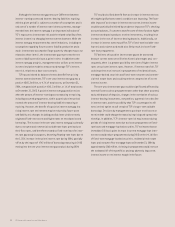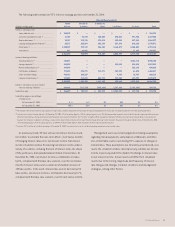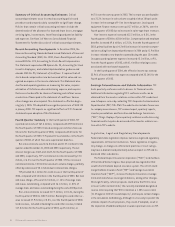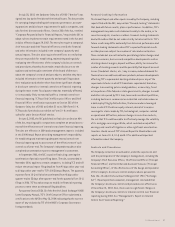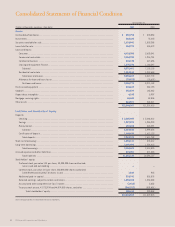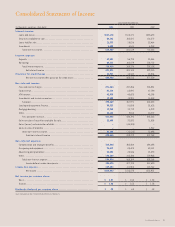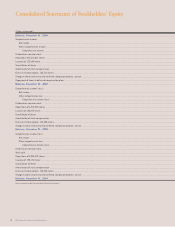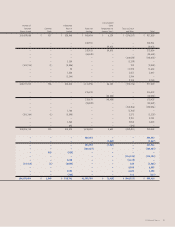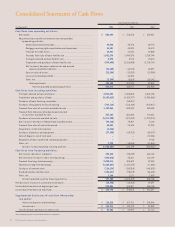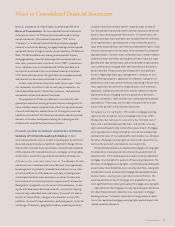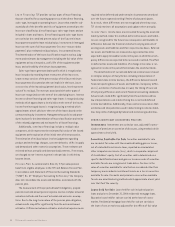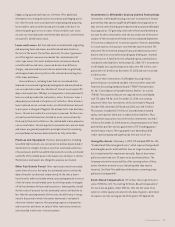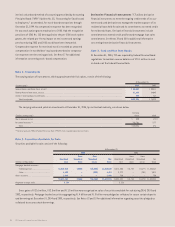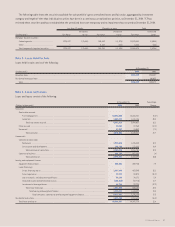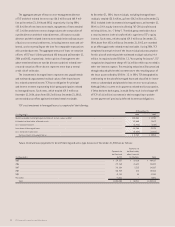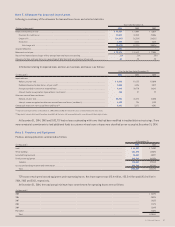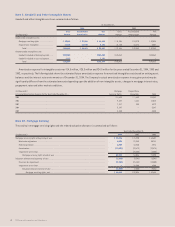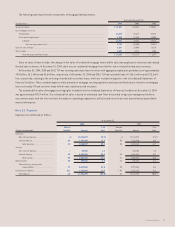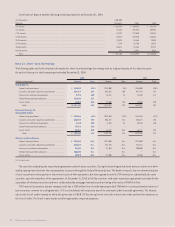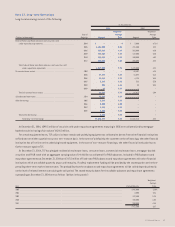TCF Bank 2004 Annual Report Download - page 56
Download and view the complete annual report
Please find page 56 of the 2004 TCF Bank annual report below. You can navigate through the pages in the report by either clicking on the pages listed below, or by using the keyword search tool below to find specific information within the annual report.
54 TCF Financial Corporation and Subsidiaries
Lease Financing TCF provides various types of lease financing
that are classified for accounting purposes as either direct financing,
sales-type, leveraged or operating leases. Leases that transfer sub-
stantially all of the benefits and risks of equipment ownership to the
lessee are classified as direct financing or sales-type leases and are
included in loans and leases. Direct financing and sales-type leases
are carried at the combined present value of the future minimum
lease payments and the lease residual value. Investments in leveraged
leases are the sum of all lease payments (less non-recourse debt
payments) plus estimated residual values, less unearned income.
The determination of the lease classification requires various judg-
ments and estimates by management including the fair value of the
equipment at lease inception, useful life of the equipment under
lease, and collectibility of minimum lease payments.
Sales-type leases generate dealer profit which is recognized at
lease inception by recording lease revenue net of the lease cost.
Lease revenue consists of the present value of the future minimum
lease payments discounted at the rate implicit in the lease. Lease
cost consists of the leased equipment’s book value, less the present
value of its residual. The revenues associated with other types of
leases are recognized over the term of the underlying leases. Interest
income on direct financing and sales-type leases is recognized using
methods which approximate a level yield over the term of the leases.
Income from leveraged leases is recognized using a method which
approximates a level yield over the term of the leases based on the
unrecovered equity investment. Management has policies and proce-
dures in place for the determination of lease classification and review
of the related judgments and estimates for all lease financings.
Additionally, some lease financings include a residual value
component, which represents the estimated fair value of the leased
equipment at the expiration of the initial term of the transaction.
The estimation of residual values involves judgments regarding
product and technology changes, customer behavior, shifts in supply
and demand and other economic assumptions. These estimates are
reviewed at least annually and downward adjustments, if necessary,
are charged to non-interest expense in the periods in which they
become known.
Pension Plan As summarized in Note 18, TCF provides pension
benefits to eligible employees in the TCF Cash Balance Pension Plan.
In accordance with Statement of Financial Accounting Standards
(“SFAS”) No. 87 “Employers’ Accounting for Pensions,” the Company
does not consolidate the assets and liabilities associated with the
pension plan.
The measurement of the projected benefit obligation, prepaid
pension asset and annual pension expense involves complex actuarial
valuation methods and the use of actuarial and economic assump-
tions. Due to the long-term nature of the pension plan obligation,
actual results may differ significantly from the actuarial-based
estimates. Differences between estimates and actual experience are
required to be deferred and under certain circumstances amortized
over the future expected working lifetime of plan participants.
As a result, these differences are not recognized when they occur.
TCF closely monitors all assumptions and updates them annually.
Income Taxes Income taxes are accounted for using the asset and
liability method. Under this method, deferred tax assets and liabili-
ties are recognized for the future tax consequences attributable to
differences between the financial statement carrying amounts of
existing assets and liabilities and their respective tax bases. Deferred
tax assets and liabilities are measured using enacted tax rates
expected to apply to taxable income in the years in which those tem-
porary differences are expected to be recovered or settled. The effect
on deferred tax assets and liabilities of a change in tax rates is rec-
ognized in income in the period that includes the enactment date.
The determination of current and deferred income taxes is based
on complex analyses of many factors including interpretation of
Federal and state income tax laws, the difference between tax and
financial reporting bases of assets and liabilities (temporary differ-
ences), estimates of amounts due or owed, the timing of reversals
of temporary differences and current financial accounting standards.
Actual results could differ significantly from the estimates and tax
law interpretations used in determining the current and deferred
income tax liabilities. Additionally, there can be no assurances that
estimates and interpretations used in determining income tax liabil-
ities may not be challenged by federal and state taxing authorities.
OTHER SIGNIFICANT ACCOUNTING POLICIES
Investments Investments are carried at cost, adjusted for amor-
tization of premiums or accretion of discounts, using methods which
approximate a level yield.
Securities Available for Sale Securities available for sale
are carried at fair value with the unrealized holding gains or losses,
net of related deferred income taxes, reported as accumulated
other comprehensive income (loss), which is a separate component
of stockholders’ equity. Cost of securities sold is determined on a
specific identification basis and gains or losses on sales of securities
available for sale are recognized at trade dates. Declines in the
value of securities available for sale that are considered other than
temporary are recorded in noninterest income as a loss on securities
available for sale. Discounts and premiums on securities available
for sale are amortized using methods which approximate a level yield
over the life of the security.
Loans Held for Sale Loans held for sale include education
loans and prior to December 31, 2004 residential mortgage loans.
Education loans held for sale are carried at the lower of cost or
market. Residential mortgage loans held for sale are carried at
the lower of cost or market as adjusted for the effects of fair value


